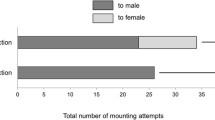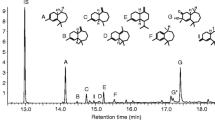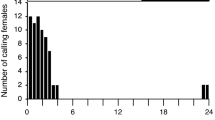Abstract
The male-produced sex pheromone of the red-shouldered stink bug, Thyanta pallidovirens (Stål) (Hemiptera: Pentatomidae) consists of a blend of methyl (E2,Z4,Z6)-decatrienoate (E2,Z4,Z6–10:COOMe), and the sesquiterpenes (+)α-curcumene, (−)-zingiberene, and (−) -β-sesquiphellandrene. In laboratory bioassays, sexually mature males attracted sexually mature females but not males, and females did not attract either sex. Extracts of volatiles collected from sexually mature males contained compounds not present in extracts from females or sexually immature males, and male-produced extract was attractive to females. Biological activity was lost when the extract was fractionated, indicating that the pheromone consisted of at least two components having different chemical properties. Individually, pheromone components were not attractive to females, but E2,Z4,Z6–10:COOMe in combination with at least one of the three male-produced sesquiterpenes was attractive. The presence of more than one sesquiterpene in the blend did not increase attraction, indicating redundancy in the pheromone signal. Male extract was as attractive as a blend reconstructed from synthesized compounds, indicating all biologically active components had been identified. In bioassays conducted at dusk in a 1- × 1- × 1-m screen field cage, females were attracted to synthetic pheromone lures. In field trials, adult female T. pallidovirens were attracted to pheromone-baited traps in relatively low numbers. The profile of volatiles released by sexually mature males of a congeneric species, Thyanta accerra custator McAtee, was remarkably similar to that of male T. pallidovirens, with the exception that the former species produced (E)-2-decenal, a compound that was not found in T. pallidovirens extracts.
Similar content being viewed by others
REFERENCES
Adams, R. P. 1995. Identification of Essential Oil Components by Gas Chromatography/Mass Spectroscopy. Allured Pub. Corp., Carol Stream, Illinois.
Aldrich, J. R. 1988. Chemical ecology of the Heteroptera. Annu. Rev. Entomol. 33:211–238.
Aldrich, J. R. 1995. Chemical communication in the true bugs and parasitoid exploitation, pp. 318–363, in R. T. Cardé and W. J. Bell (eds.). Chemical Ecology of Insects II. Chapman & Hall, New York.
Aldrich, J. R., Lusby, W. R., Marron, B. E., Nicolau, K. C., Hoffmann, M. P., and Wilson, L. T. 1989. Pheromone blends of green stink bugs and possible parasitoid selection. Naturwissenschaften 76:173–175.
Aldrich, J. R., Hoffmann M. P., Kochansky, J. P., Lusby, W. R., Eger, J. E., and Payne, J. A. 1991. Identification and attractiveness of a major pheromone component for Nearctic Euschistus spp. stink bugs (Heteroptera: Pentatomidae). Environ. Entomol 20:477–483.
Aldrich, J. R., Numata, H., Borges, M., Bin, F., Waite, G. K., and Lusby, W. R. 1993. Artifacts and pheromone blends from Nezara spp. and other stink bugs (Heteroptera: Pentatomidae). Z. Naturforsch. 48C:73–79.
Aldrich, J. R., Rossi, M. C., and Bin, F. 1995. Behavioral correlates for minor volatile compounds from stink bugs (Heteroptera: Pentatomidae). J. Chem. Ecol. 21:1907–1920.
ANONYMOUS. 1991. Integrated Pest Management for Apples and Pears. University of California Statewide IPM Project, DANR Pub. #3340.
Borges, M., Schmidt, F. G. V., Sujii, E. R., Medeiros, M. A., Mori, K., Zarbin, P. H. G., and Ferreira, J. T. B. 1998. Field responses of stink bugs to the natural and synthetic pheromone of the Neotropical brown stink bug, Euchistus heros (Heteroptera: Pentatomidae). Physiol. Entomol. 23:202–207.
Buckingham, J. (ed.). 1994. Dictionary of Natural Products, 1st ed. Chapman & Hall, London.
Chavan, S. P., Dhondge, V. D., Patil, S. S., Rao, Y. T. S., and Govande, C. A. 1997. Enantiospecific total synthesis of (C)-laevigatin. Tetrahedron Asymm. 8:2517–2518.
Çokl, A., McBrien, H. M., and Millar, J. G. 2001. Comparison of substrate-borne vibrational signals of two stink bug species, Acrosternum hilare (Say) and Nezara viridula (L.) (Heteroptera: Pentatomidae). Ann. Entomol. Soc. Am. 94:471–479.
Daane, K. M., Steffan, S.A., Yokota, G. Y., and Michaelides, T. J. 2000. Biological investigations of hemipteran pests to improve control and reduce the spread of the fungus Botryosphaeria dothidea. California Pistachio Industry Annual Report, CropYear 1999-2000; California Pistachio Commission, Fresno California, pp. 119–120.
Federici, B. A. 1999. Broadscale use of pest-killing plants to be true test. Cal. Agric. 52:14–20.
Gilby, A. R. and Waterhouse, D. F. 1965. The composition of the scent of the green vegetable bug Nezara viridula. Proc. R. Soc. London, Ser. B, Biol. Sci. 162:105–120.
Greene, J. K., Turnipseed, S. G., Sullivan, M. J., and Herzog, G.A. 1999. Boll damage by southern green stink bug (Hemiptera: Pentatomidae) and tarnished plant bug (Hemiptera: Miridae) caged on transgenic Bacillus thuringiensis cotton. J. Econ. Entomol. 92:941–944.
Hall, S. S., McEnroe, F. J., and Shue, H.-J. 1975. A convenient synthesis of the sesquiterpene (α)-α)-curcumene. VI. Application of alkylation-reduction to the total synthesis of terpenes. J. Org. Chem. 40:3306–3307.
Harris, V. E. and Todd, J. W. 1980. Male-mediated aggregation of male, female and 5th-instar southern green stink bugs and concomitant attraction of a tachinid parasite, Trichopoda pennipes. Entomol. Exp. Appl. 27:117–126.
Ho, H.-Y. and Millar, J. G. 2001a. Identification and synthesis of a male produced sex pheromone from the stink bug Chlorochroa sayi. J. Chem. Ecol. 27:1177–1201.
Ho, H.-Y. and Millar, J. G. 2001b. Identification and synthesis of male-produced sex pheromone components of the stink bugs Chlorochroa ligata and Chlorochroa uhleri. J. Chem. Ecol. 27:2067–2095.
Jackman, L. M. 1960. Hydrogenation-dehydrogenation reactions, pp. 329–364 in R. Raphael, E. C. Taylor, and H. Wynberg (eds.). Advances in Organic Chemistry. Methods and Results. Volume II. Interscience Publishers, New York.
James, D. G., Heffer, R., and Amaike, M. 1996. Field attraction of Biprorulus bibax Breddin (Hemiptera: Pentatomidae) to synthetic aggregation pheromone and (E)-2-hexenal, a pentatomid defense chemical. J. Chem. Ecol. 22:1697–1708.
Joulain, D. and KÖnig, W. A. 1998. The Atlas of Spectral Data of Sesquiterpene Hydrocarbons. E.B.-Verlag, Hamburg, Germany.
KÖnig, W. A., Rieck, A., Hardt, I., Gehrcke, B., Kubeczka, K.-H., and Muhle, H. 1994. Enantiomeric composition of the chiral constituents of essential oils. Part 2: Sesquiterpene hydrocarbons. J. High Resolut. Chromatogr. 17:315–320.
Leal, W. S., Kuwahara, S., Shi, X. W., Higuchi, H., Marino, C. E. B., Ono, M., and Meinwald, J. 1998. Male-released sex pheromone of the stink bug Piezodorus hybneri. J. Chem Ecol. 24:1817–1829.
Lucchi, A. 1994. The scent gland system of Nezara viridula (L.) (Heteroptera Pentatomidae). III. Male ventral abdominal glands. Redia 77:1–10.
Marques, F. A., McElfresh, J. S., and Millar, J. G. 2000. Female-produced sex pheromone of the predatory bug Geocoris punctipes. J. Chem. Ecol. 26:2843–2855.
McBrien, H.M. and Millar, J.G. 1999. Phytophagous bugs, pp. 277–304 in J. Hardie and A. K. Minks (eds.). Pheromones of Non-Lepidopteran Insects Associated with Agricultural Plants. CABI Publishers, Wallingford, United Kingdom.
McBrien, H. M., Millar, J. G., Gottlieb, L., Chen, X., and Rice, R. E. 2001. Male produced sex attractant pheromone of the green stink bug, Acrosternum hilare. J. Chem. Ecol. 27:1821–1839.
McGhee, P. and Brunner, J. F. 1996. Biology and management of stink bugs in tree fruit. Paper 0423, Annual Meeting of the Entomological Society of America, Louisville, Kentucky, December 8-12, 1996.
McPherson, J. E. and McPherson, R. M. 2000. Stink Bugs of Economic Importance in America North of Mexico. CRC Press, Boca Raton, Florida.
Miklas, N., Renou, M., Çokl, A., and Virant-Doberlet, M. 1999. Songs and pheromone interplay in sexual communication in Nezara viridula (Heteroptera: Pentatomidae). Poster #111, 16th Annual Meeting, International Society of Chemical Ecology; Marseille, November 13-17, 1999.
Millar, J. G. 1997. Methyl (2E,4Z,6Z)-deca-2,4,6-trienoate, a thermally unstable, sex-specific compound from the stink bug Thyanta pallidovirens. Tetrahedron Lett. 38:7971–7972.
Millar, J. G. 1998. Rapid and simple isolation of zingiberene from essential oils. J. Nat. Prod. 61:1025–1026.
Millar, J. G., Rice, R. E., Steffan, S. A., Daane, K. M., Cullen, E., and Zalom, F. G. 2001. Attraction of female digger wasps, Astata occidentalis Cresson (Hymenoptera: Sphecidae) to the sex pheromone of the stink bug Thyanta pallidovirens. Pan-Pac. Entomol. 77:244–248.
Mitchell, W. C. and Mau, R. F. L 1971. Response of the female southern green stink bug and its parasite, Trichopoda pennipes, to male stink bug pheromones. J. Econ. Entomol. 64:856–859.
Ota, D. and Çokl, A. 1991. Mate location in the southern green stink bug, Nezara viridula, mediated through substrate-borne signals on ivy. J. Insect Behav. 4:441–447.
Pavis, C. and Malosse, C. 1986. A sex pheromone produced by mature males in the southern green stink bug, Nezara viridula (L.) (Heteroptera: Pentatomidae). C. R. Acad. Sci. III-Sci. Vie 303:273–276.
Rice, R. E., Bentley, W. J., and Beede, R. H. 1988. Insect and mite pests of pistachios in California. University of California Division of Agricultural and Natural Resources, Pub #21452, Oakland, California.
Rider, D. A. and Chapin, J. B. 1992. Revision of the genus Thyanta Stål, 1862 (Heteroptera: Pentatomidae) II. North America, Central America, and theWest Indies. J. N.Y. Entomol. Soc. 100:42–98.
Schaefer, C. W. and Panizzi, A. R. (eds.). 2000. Heteroptera of Economic Importance. CRC Press, Boca Raton, Florida.
Schotzko, D. J. and O'keeffe, L. E. 1990. Effect of pea and lentil development on reproduction and longevity of Thyanta pallidovirens (Stal) (Hemiptera, Heteroptera, Pentatomidae. J. Econ. Entomol. 83:1333–1337.
Steel, R. G. D., Torrie, J. H., and Dickey, D. A. 1997. Principles and Procedures of Statistics: A Biometrical Approach, 3rd ed. McGraw-Hill, New York.
Sugie, H., Yoshida, M., Kawasaki, K., Noguchi, H., Moriya, S., Takagi, K., Fukuda, H., Fujiie, A., Yamanaka, M., Ohira, Y., Tsutsumi, T., Tsuda, K., Fukumoto, K., Yamashita, M., and Suzuki, H. 1996. Identification of the aggregation pheromone of the brown-winged green bug, Plautia stali Scott (Heteroptera: Pentatomidae). Appl. Entomol. Zool. 31:427–431.
Sy, L.-K. and Brown, G. D. 1997. Total assignment of the 1H and 13C NMR chemical shifts of three bisabolane hydrocarbons by 2D-NMR spectroscopy. Magn. Reson. Chem. 35:424–425.
Turnipseed, S. G. and Greene, J. K. 1996. Strategies for managing stink bugs in transgenic B. t. cotton. Proceedings, 1996 Beltwide Cotton Conference, National Cotton Council of America, Memphis, Tennessee, pp. 936–938. WANG, Q. and MILLAR, J. G. 1997. Reproductive behavior of Thyanta pallidovirens (Heteroptera: Miridae). Ann. Entomol. Soc. Am. 90:380-388.
Wilson, F. D., Flint, H. M., Deaton, W. R., Fischoff, D. A., Perlak, F. J., Armstrong, T. A., Fuchs, R. L., Berberich, S. A., Parks, N. J., and Stapp, B. R. 1992. Resistance of cotton lines containing a Bacillus thuringiensis toxin to pink bollworm (Lepidoptera: Gelechiidae) and other insects. J. Econ. Entomol. 85:1516–1521.
Zar, J. H. 1984. Biostatistical Analysis, 2nd ed. Prentice-Hall, Englewood Cliffs, New Jersey.
Author information
Authors and Affiliations
Corresponding author
Rights and permissions
About this article
Cite this article
McBrien, H.L., Millar, J.G., Rice, R.E. et al. Sex Attractant Pheromone of the Red-Shouldered Stink Bug Thyanta pallidovirens: A Pheromone Blend with Multiple Redundant Components. J Chem Ecol 28, 1797–1818 (2002). https://doi.org/10.1023/A:1020513218454
Issue Date:
DOI: https://doi.org/10.1023/A:1020513218454




